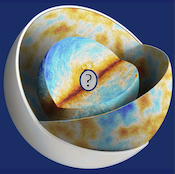The Simons Observatory is an ensemble of telescopes being progressively deployed on Cerro Toco (Chile), aiming at measuring both small and large angular scales of the cosmic microwave background. Three Small Aperture Telescopes have been successfully installed on site and started operating from late 2023. These half-meter mirrors telescopes are designed to measure the large-scale polarization...
Over the past year, the proposal to build a high-frequency Small Aperture Telescope (SAT) to add to the Simons observatory has gradually become more and more consolidated. This project named Kairos is currently submitted for funding to the RI2 CNRS program (Recherche à risque et à impact) and has obtained the support of three institutes (IN2P3, INSU and INP). We propose to deploy a focal plane...
Rayleigh scattering of the Cosmic Microwave Background (CMB) is a less studied yet potentially powerful probe of the recombination history. Scattering of CMB photons off neutral species right after recombination presents a distinctive $\nu^4$ scaling with frequency as well as a strong correlation with the primary CMB. These unique features should facilitate its detection by the next generation...
The quest for primordial B-mode polarisation in the cosmic microwave background poses significant analysis challenges. Because the signal is so faint, robust measurements (or constraints) require a particular attention to systematic effects, astrophysical foregrounds, as well as the interplay between the two. This task is made even more difficult by the volume and complexity of the datasets...
Component separation is the crucial and challenging analysis step to estimate the CMB signal in the presence of astrophysical contaminants.
The Galactic dust and synchrotron are the primary millimeter emissions to remove in the search for primordial CMB B-modes.
One major unknown is the full complexity of the polarized astrophysical foreground spectral properties, which is yet to be assessed...
In the context of future experiments measuring the polarization of the Cosmic Microwave Background (CMB), COSMOCal proposes a method independent of laboratory calibration of CMB instruments and cosmological model assumptions to calibrate next-generation millimeter-wave telescopes. The primary objective is to achieve polarization angle calibration with a precision better than 0.1 degrees. This...
The ambitious quest to detect the faint B-modes of CMB polarization, pursued by projects like the Simons Observatory (SO) and LiteBIRD, requires rigorous control over systematic effects in polarimetry. The PolarKID project, supported by CNES (2023–2025), is dedicated to testing LEKIDs in a filled array configuration to demonstrate their capability for precise polarization detection. This setup...

